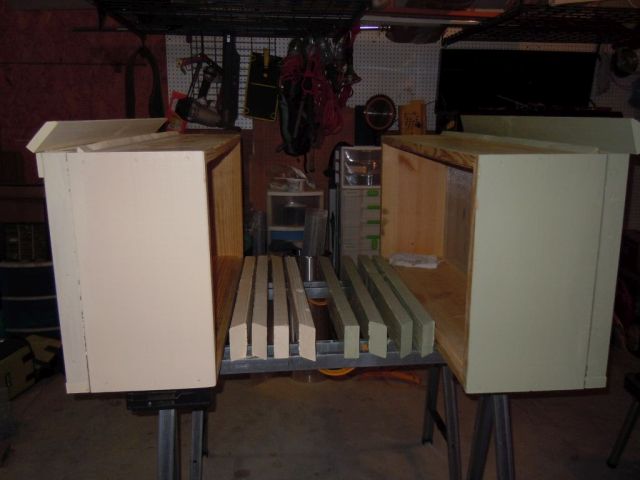
I’m busy building two more horizontal hives in accordance with Dr. Leo’s plans at…
It’s an excellent design, and I’m convinced it’s a way better way to keep my bees than the standard Langstroth stack. The walls are extra thick (1.5 inches), and the gable roof is thickly insulated and has aluminum sheathing which makes it easier for the bees to heat and cool their brood nest.
I found that rainwater gets into the oil trays of the first hive I made, so I cut a 45° bevel on the top edge of the new hives’ back door flaps, and then stapled the waste piece from the bevel cut right above the door to act as a drip edge.
I also changed the style of the butt joints of the main box. I made the long front and back boards longer, and cut rabbets into the ends of the four box boards. The idea was to strengthen the main joints by increasing the glue surface area, and allowing me to drive screws in both directions. But that was a bad idea in practice. First of all, I neglected to make the front and back boards long enough, so instead of holding 31 deep frames, one of the boxes will only hold 30. I compensated for my calculation mistake on the second hive by making the rabbets shallower in the length direction. Although that solved the length issue for the second hive, I would still have been better off with the original butt joints. I didn’t notice when I picked out the 2x12s for the boxes, but one of them had a slight twist. So although my nice interlocking rabbet joints are nice and tight, the box itself is slightly bowed. Instead of sitting flat on the concrete floor, it wobbles slightly (about 1/4 inch). It’s not enough of a bow to impact the installation of frames, the level of the oil trap trays, or the fit of the gable roof, and I can compensate for the wobble when I install the legs, but if I’d used the butt joints in Dr. Leo’s design, I wouldn’t have the wobble problem in the first place. Simpler is better, right?
I’m building these hives with the screen bottom with oil trap trays and gable roof. I haven’t run the numbers completely, but I think Dr. Leo’s materials cost estimates are just about right. In fact, by building all three designs (horizontal Langstroth hive, screen bottom, and gable roof) in concert, there is some savings in materials (aluminum sheet, and plywood sheathing) overall which can be obtained by strategic cutting of the plywood.
I also had to cut the frame pieces for the bottom oil trap chamber a little thicker than Dr. Leo’s design called for, so that my oil pans will fit tightly leaving no gaps for the small hive beetle larvae to drop through onto the ground to pupate. Instead of ripping the 2 x 4 into 1 x 2 pieces, they are 1-1/2 x 2. That makes them easier to mount on the bottom of the hive boxes anyway. The trays I’m using are from Nile traps I got at Johnson’s Bees and Supplies. WalMart no longer sells the plastic storage bins that had the perfect size lids I used as oil trap trays on the first hive I built. 🙁
But I must say that Dr. Leo must have some special honey that he eats while building his hives, which lets him work really fast. Either that or his build time estimates are “somewhat optimistic.” For example, he says the horizontal hive build (without screen bottom or gable roof) is a two hour project. I’m about four days in at this point, and I am just now starting on the gable roofs. Heck. It took me more than two hours just to put two coats of paint on the two boxes and their legs. I don’t claim to be a master carpenter – far from it. But I’ve picked up some woodworking skills over the years, and I do have all the tools I need for this project. Nor am I a young buck like Dr. Leo, but I think when all’s said and done this project will be about two weeks for two hives. Maybe I just need some of that special hive-building honey Dr. Leo eats.
More pictures to follow as the project continues…
(;~)}}}
